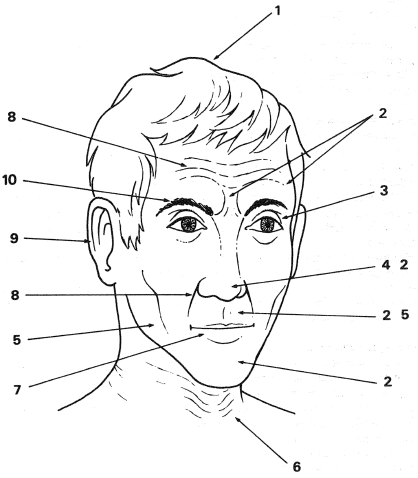The Aims of Makeup
Television makeup treatment takes three broad forms;
• ‘Straight makeup’ — general improvement, without altering the basic appearance.
• ‘Corrective makeup’—compensatory makeup, enhancing the features, and suppressing/disguising facial defects.
• ‘Character makeup’ —changing the appearance to conform with a particular type or character.
The value of makeup
Sometimes a person’s natural complexion, or everyday makeup, looks fine on camera, and no additional treatment is needed, apart from tidying the hair, and a few touches to neaten their appearance – treating perspiration around temples and brow, or a distracting shine on the nose, forehead or bald head.
A straight makeup aims to improve the talent’s overall appearance, while altering it as little as possible. Treatment can help, for instance, to even out a blotchy complexion, reduce bags under the eyes, improve skin tones, or subdue a dark beard line.
Makeup can give vitality and form to a face that the camera shows as rather lacking definition. It can emphasize the more attractive points, while reducing less flattering features, Makeup can strengthen and enhance in many ways; e.g. by making the hairline more definite; or strengthening the jaw line, chin or nose by subtle shading to improve their shape.
The magic of makeup
All makeup relies on a series of quite simple principles; but the subtlety with which they are applied is the secret of the art.
•Lighter tones advance, and make an area look more prominent, and larger.
•Darker tones recede, and make an area look less prominent, and smaller,
•Progressive shading can alter the apparent contours of a surface; e.g. so that cheeks appear to recede.
•Makeup can obliterate an existing feature, and by redrawing, shading or highlighting, create another– e.g. eyebrows.
•Makeup can emphasize a feature –e.g. making eyes more prominent.
•Existing features can be physically readjusted – e.g. taping back ears.
•Skin can be stretched, contracted, built up – e.g. simulating wounds, scars.
•Existing features can be augmented – e.g. morticians’ wax and nose plugs to change nose shape.
•Existing features can be hidden – e.g. ‘bald head’ cap worn over hair to create a ‘shaven head’ look.
General Practice
Where makeup cannot be carried out beforehand, the makeup artist has to rely on experience to select the most suitable treatment. Wherever possible, though, it is better for the talent to be made up before camera rehearsal. The makeup artist then carefully checks rehearsal shots, and notes whether any changes are needed. Before recording, this treatment is refurbished (‘freshened up’) as necessary.
Basic makeup improvements
Makeup can help to improve or hide various visual shortcomings:
1 Shiny bald head. Untidy hair. Scalp shows through thin hair. Hair too light,or dark and dense to show well on camera.
2 Perspiration shine.
3 Deep eye sockets. Eyes too prominent. Eyes lack definition.
4 Shiny nose. Nose coloration prominent.
5. Beard-line prominent despite shaving.
6 Neck scrawny.
7 Normal lipstick too light or dark on camera. Lips need definition or shaping.
8 Age-lines, wrinkles, over-prominent.
9 Ears too light; different color from adjacent skin. Too prominent.
10 Eyebrows untidy; over-prominent; barely discernible.

